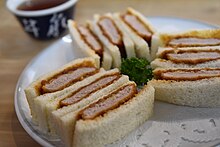This article has multiple issues. Please help improve it or discuss these issues on the talk page. (Learn how and when to remove these messages)
|
 reference image of a katsu-sando reference image of a katsu-sando | |
| Type | Sandwich |
|---|---|
| Place of origin | Japan |
| Region or state | Tokyo |
| Invented | 1935 |
| Main ingredients | |

Katsu-sando (Japanese: カツサンド or かつサンド, lit. 'cutlet sandwich') is a Japanese sandwich which made from Japanese-style cutlet (mainly tonkatsu) between slices of bread, and there are many variations.
The price and quantity of it are reasonable, so it is also served as a hassle-free snack or bento (e.g.,Tokyo Station's ekiben, Haneda Airport's soraben [ja]).
History
Katsu-sando was invented in 1935 by Toki Ishizaka, the landlady of a tonkatsu restaurant "Isen [ja]" in Ueno, Tokyo, who was inspired by ham sandwich, and was officially called "かつサンド" (not "カツサンド"). At the time of its invention, Isen was frequented by geishas of a hanamachi, so Isen made it with special ordered small breads to prevent their lipstick from coming off, and Isen was famous for its tender cutlet made with carefully pounded meat which could be cut with chopsticks.
Manufacturing method
A typically katsu-sando made from tonkatsu between Japanese milk bread and served cut into rectangular or triangular pieces. Tonkatsu sauce is used as a seasoning, and sometimes karashi is also used. The bread may be toasted. Julienned cabbage is often placed on between slices of the bread along with tonkatsu.
In Tokyo, "hirekatsu-sando" (ヒレかつサンド, lit. 'pork fillet cutlet sandwich') of Maisen (a restaurant in Omotesandō) and "mankatsu-sando" (万かつサンド, lit. 'Mansei's cutlet sandwich') of Mansei [ja] (a restaurant in Akihabara) are well known, and these are sometimes featured as rokeben [ja] for television programs and movie shoots. "hirekatsu-sando" of Maisen made from pork fillet cutlet and "mankatsu-sando" of Mansei made from pork loin cutlet.
Katsu-sando is sometimes eaten the night before an important exam or competition like other Japanese cutlet dishes. This is because "katsu" is a homophone of the verb katsu (勝つ), meaning "to win" or "to be victorious".
Types

There are many types of katsu-sandos, including those which use bread other than Japanese milk bread, those which use cutlet other than tonkatsu such as gyū-katsu or chicken katsu, those which use different seasonings, and those which use vegetables, and there are also differences depending on the region.
In Aomori Prefecture, katsu-sando is known as a sandwich which made from chicken katsu between koppe pan [ja].
In Nagoya and its suburbs, "misokatsu [ja]-sando" (味噌カツサンド, lit. 'miso cutlet sandwich') is sold in many places, and katsu-sando made with worcestershire sauce is sometimes called "sōsukatsu-sando" (ソースカツサンド, lit. 'sauce cutlet sandwich').
In the Kansai region, katsu-sando is often made with gyū-katsu, and it using tonkatsu is sometimes called "tonkatsu-sando" (豚カツサンド, lit. 'tonkatsu sandwich'). In addition, "aburamisokatsu-sando [ja]" (油味噌かつサンド, lit. 'andansū cutlet sandwich') which use andansū [ja] as a seasoning is also sold.
Katsu-sando made with round buns are also sold in hamburger restaurants in Japan, and in addition to tonkatsu, it also use chicken katsu, menchi-katsu, and ebi-katsu [ja].
See also
References
- "【2020年公式】東京駅新ショップ テイクアウトランキングTOP5!". TOKYOINFO. 鉄道会館. 1 October 2020. Retrieved 6 December 2020.
- "羽田空港空弁人気ランキングベスト5+注目空弁をご紹介!". Smart Magazine 東京. ジェイトリップ. 16 September 2017. Retrieved 6 December 2020.
- 清水麻帆 (17 October 2021). "みんな大好き「かつサンド」 初期ブームを作ったのは花街の芸者だった!". アーバンライフ東京. オアシス. Retrieved 11 May 2024.
- あのメニュー 2013, p. 72
- "万かつサンド". 株式会社 万世. Retrieved 17 January 2023.
- "長堀の鉄板料理店で「開運アゲアゲ勝つサンド」食べて験担いで". なんば経済新聞. ラプレ. 25 December 2019. Retrieved 6 December 2020.
- "ニューカツサンド". 株式会社 工藤パン. Retrieved 17 January 2023.
Further reading
- 菊地武顕 (13 November 2013). あのメニューが生まれた店. 平凡社. ISBN 978-4582634860.
| Japanese food and drink | |||||||||
|---|---|---|---|---|---|---|---|---|---|
| Shushoku |
| ||||||||
| Okazu | |||||||||
| Soup (Shirumono) | |||||||||
| Set menu | |||||||||
| Beverages |
| ||||||||
| Snacks / desserts/ Wagashi | |||||||||
| Fruits | |||||||||
| Ingredients / condiments | |||||||||
| Utensils | |||||||||
| Lists | |||||||||
| Related | |||||||||
This bread-related article is a stub. You can help Misplaced Pages by expanding it. |
This Japanese cuisine–related article is a stub. You can help Misplaced Pages by expanding it. |